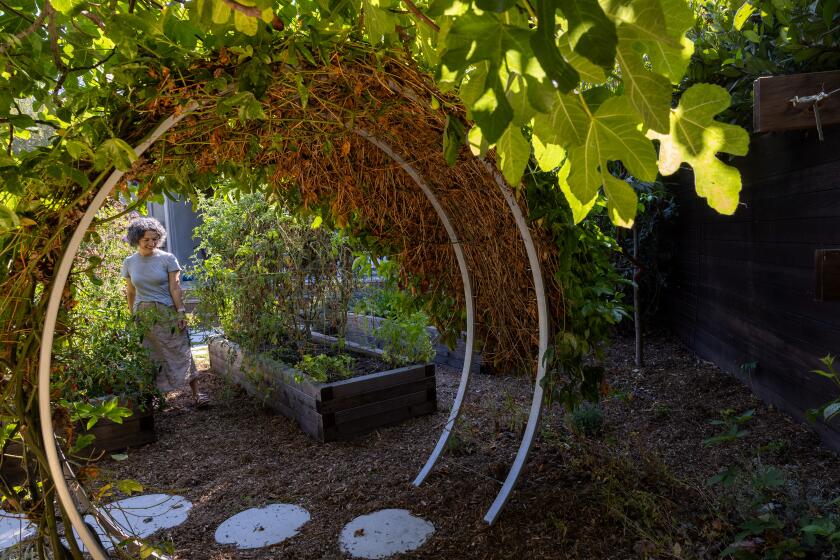Florists Find Wild Thistle Elicits Clients’ Wolf Whistles
For years, environmentalists have been tearing their hair out over that pernicious weed, the artichoke thistle, which invades wild lands throughout Orange County and crowds out native plants.
But now, designer florists are finding a saving grace in the otherwise nasty plant. They’re using the flower, in blossom right now, in their arrangements, where it makes a dramatic addition.
Many high-end florists gush about the thistle’s qualities, calling it “unique” and a “showstopper.”
The California Exotic Plant Council has a different label for the plant: one of the 10 most invasive wild-land weeds.
Last year about this time, firefighters were burning 48 acres of Crystal Cove State Park, in part to eliminate the fast-spreading, exotic plants. But don’t tell that to the floral designers who lovingly arrange the cuttings, which look like small artichokes topped with a head of spiky periwinkle hair.
“When they are in season, we carry them as much as possible,” says Lynda Douthitte, a designer at Artistic Florists in Costa Mesa. “They are a very dramatic flower.”
Linda Shimokaji, co-owner of Bell Tower Florist and Gifts in Lake Forest, agrees.
She tries to have at least a few of them in stock for the special orders. Her corporate clients, especially, appreciate the unusual touch.
“I guess they’re just kind of amazed that something like that is going into an arrangement,” she said.
Not all florists have gone gaga over this weed, however. Its popularity withers among shops that stick to the more traditional rose, carnation and baby’s-breath arrangements. And some florists say the thistle is dangerous. Parts of the spiny plants can be as sharp as needles.
“We do a great many creative things but we haven’t gotten into artichokes lately,” says John Castor, owner of the Crystal Orchid in Laguna Niguel. On the hill behind his shops, he said, the thistles are abundant, but he wouldn’t dare pick them himself.
“They are a difficult product to work with, No. 1, and they are extremely prickly. I would not want a client or their child[ren] putting their hands into the arrangement and having a part of the weed or flower harm them.”
Besides, the floral designer says, he’s been there and done that. Thirty years ago, he was dyeing the thistles in greens, reds and blues to make them look even more unusual.
The weed is not native to California, but when one drives along the highways in the southern part of the county and in northern San Diego County, one would never know it. One florist jokingly called them “roadsidia.”
They were brought to the United States about 100 years ago by European immigrants who planted them in their backyards as edible artichokes. The plant quickly went wild.
In Crystal Cove State Park, the problem with the overpowering plant has receded somewhat in the last few years, said John Kalko, a state park ranger who has been there since 1979.
Kalko said he was not aware the weed was being used as a decorative item that could one day end up in his living room in a flower arrangement. He said jokingly that florists could, “come down here and take all they want.” After a moment, he regretted the remark and said park guests would be breaking the law if they took anything, even the ubiquitous thistles.
Although the thistles are definitely abundant, many florists rely on traders who drop by their shops weekly and sell the thistles, or on wholesalers.
At least one shop owner drives to the downtown L.A. Flower Market every couple of days to get the thistles.
Mayesh Wholesale, which sells to about 100 florists in the area, has about 25 clients who, according to manager Cindy Huntzinger, regularly purchase the thistle at $2.50 to $3.50 a stem from enterprising workers who go out to pick them among the scrub.
The owner of one high-end shop loves the thistle.
Diane Glorie says that in her shop, Atrium Court Flowers at Fashion Island in Newport Beach, “You will never see us working with carnations.”
Glorie and her Dutch-born husband, Theo, concentrate on a more sophisticated clientele. They have a reputation among their peers for working with the artichoke thistle and other offbeat plants and vegetables.
Even though Glorie says she has been “attacked” by the thorny flowers, she uses them as the focal point in many of her arrangements. They are usually placed in the middle of the grouping, with a complementary cluster of such blossoms as ginger or sunflowers.






